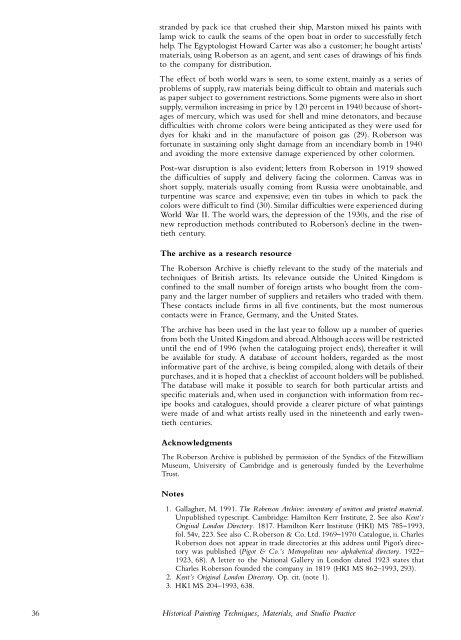Historical Painting Techniques, Materials, and Studio Practice
You also want an ePaper? Increase the reach of your titles
YUMPU automatically turns print PDFs into web optimized ePapers that Google loves.
str<strong>and</strong>ed by pack ice that crushed their ship, Marston mixed his paints with<br />
lamp wick to caulk the seams of the open boat in order to successfully fe tch<br />
help. The Egyptologist Howard Carter was also a customer; he bought artists'<br />
materials, using Roberson as an agent, <strong>and</strong> sent cases of drawings of his finds<br />
to the company fo r distribution.<br />
The effect of both world wars is seen, to some extent, mainly as a series of<br />
problems of supply, raw materials being difficult to obtain <strong>and</strong> materials such<br />
as paper subject to government restrictions. Some pigments were also in short<br />
supply, vermilion increasing in price by 120 percent in 1940 because of shortages<br />
of mercury, which was used fo r shell <strong>and</strong> mine detonators, <strong>and</strong> because<br />
difficulties with chrome colors were being anticipated as they were used fo r<br />
dyes fo r khaki <strong>and</strong> in the manufacture of poison gas (29). Roberson was<br />
fortunate in sustaining only slight damage from an incendiary bomb in 1940<br />
<strong>and</strong> avoiding the more extensive damage experienced by other colormen.<br />
Post-war disruption is also evident; letters from Roberson in 1919 showed<br />
the difficulties of supply <strong>and</strong> delivery facing the colormen. Canvas was in<br />
short supply, materials usually coming from Russia were unobtainable, <strong>and</strong><br />
turpentine was scarce <strong>and</strong> expensive; even tin tubes in which to pack the<br />
colors were difficult to find (30). Similar difficulties were experienced during<br />
World War II. The world wars, the depression of the 1930s, <strong>and</strong> the rise of<br />
new reproduction methods contributed to Roberson's decline in the twentieth<br />
century.<br />
The archive as a research resource<br />
The Roberson Archive is chiefly relevant to the study of the materials <strong>and</strong><br />
techniques of British artists. Its relevance outside the United Kingdom is<br />
confined to the small number of foreign artists who bought from the company<br />
<strong>and</strong> the larger number of suppliers <strong>and</strong> retailers who traded with them.<br />
These contacts include firms in all five continents, but the most numerous<br />
contacts were in France, Germany, <strong>and</strong> the United States.<br />
The archive has been used in the last year to follow up a number of queries<br />
from both the United Kingdom <strong>and</strong> abroad. Although access will be restricted<br />
until the end of 1996 (when the cataloguing project ends), thereafter it will<br />
be available for study. A database of account holders, regarded as the most<br />
informative part of the archive, is being compiled, along with details of their<br />
purchases, <strong>and</strong> it is hoped that a checklist of account holders will be published.<br />
The database will make it possible to search for both particular artists <strong>and</strong><br />
specific materials <strong>and</strong>, when used in conjunction with information from recipe<br />
books <strong>and</strong> catalogues, should provide a clearer picture of what paintings<br />
were made of <strong>and</strong> what artists really used in the nineteenth <strong>and</strong> early twentieth<br />
centuries.<br />
Acknowledgments<br />
The Roberson Archive is published by permission of the Syndics of the Fitzwilliam<br />
Museum, University of Cambridge <strong>and</strong> is generously funded by the Leverhulme<br />
Trust.<br />
Notes<br />
1. Gallagher, M. 1991. The Roberson Archive: inventory oj written <strong>and</strong> printed material.<br />
Unpublished typescript. Cambridge: Hamilton Kerr Institute, 2. See also Kent's<br />
Original London Directory. 1817. Hamilton Kerr Institute (HKI) MS 785-1993,<br />
fol. 54v, 223. See also C. Roberson & Co. Ltd. 1969-1970 Catalogue, ii. Charles<br />
Roberson does not appear in trade directories at this address until Pigot's directory<br />
was published (Pigot & Co. 's Metropolitan new alphabetical directory. 1922-<br />
1923, 68). A letter to the National Gallery in London dated 1923 states that<br />
Charles Roberson founded the company in 1819 (HKI MS 862-1993, 293).<br />
2. Kent's Original London Directory. Op. cit. (note 1).<br />
3. HKI MS 204-1993, 638.<br />
36<br />
<strong>Historical</strong> <strong>Painting</strong> <strong>Techniques</strong>, <strong>Materials</strong>, <strong>and</strong> <strong>Studio</strong> <strong>Practice</strong>


